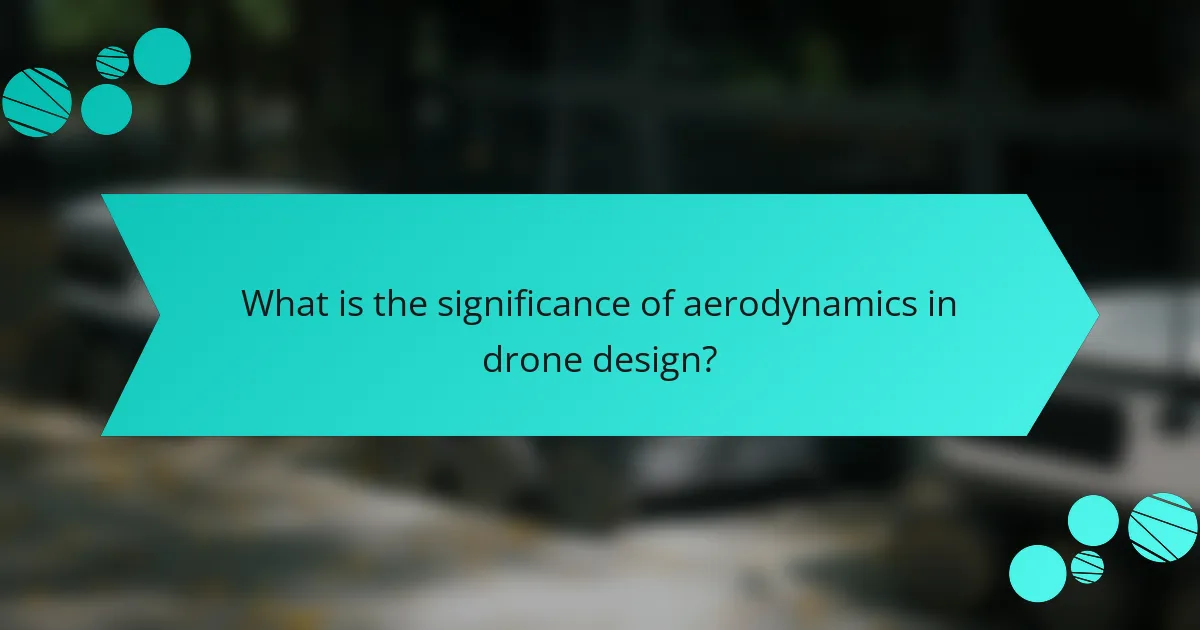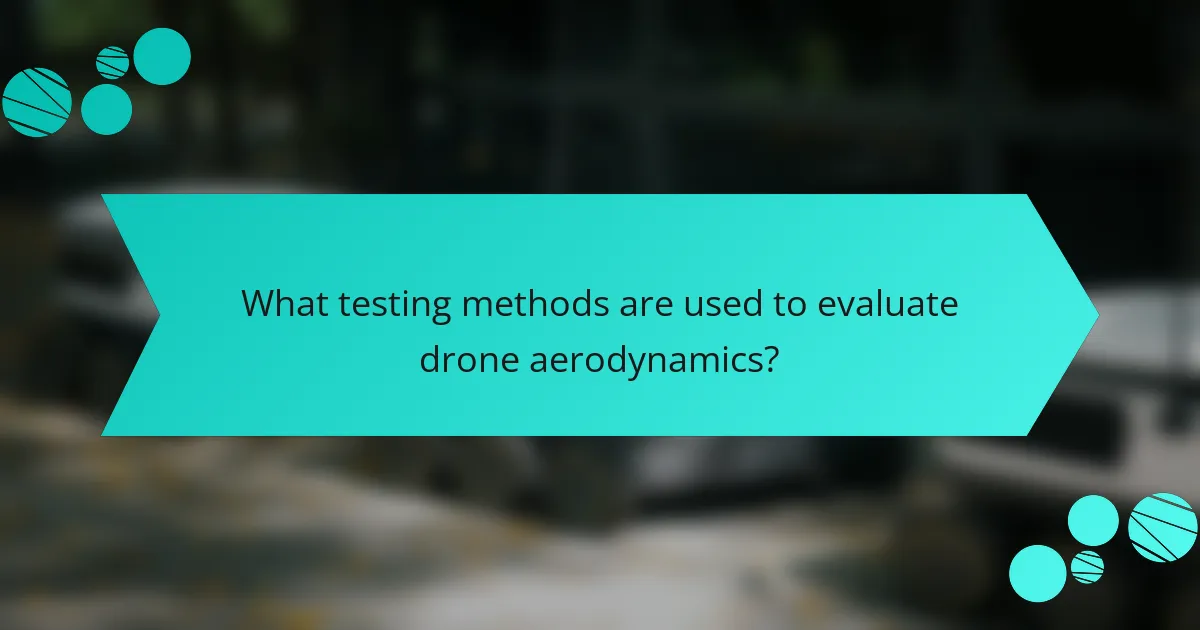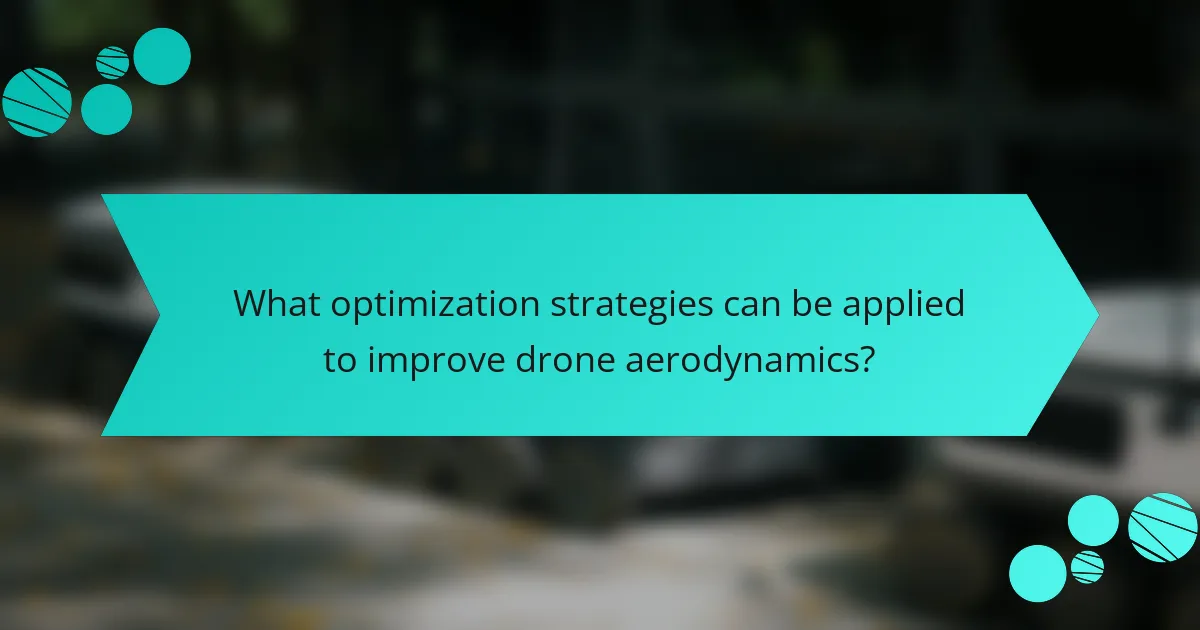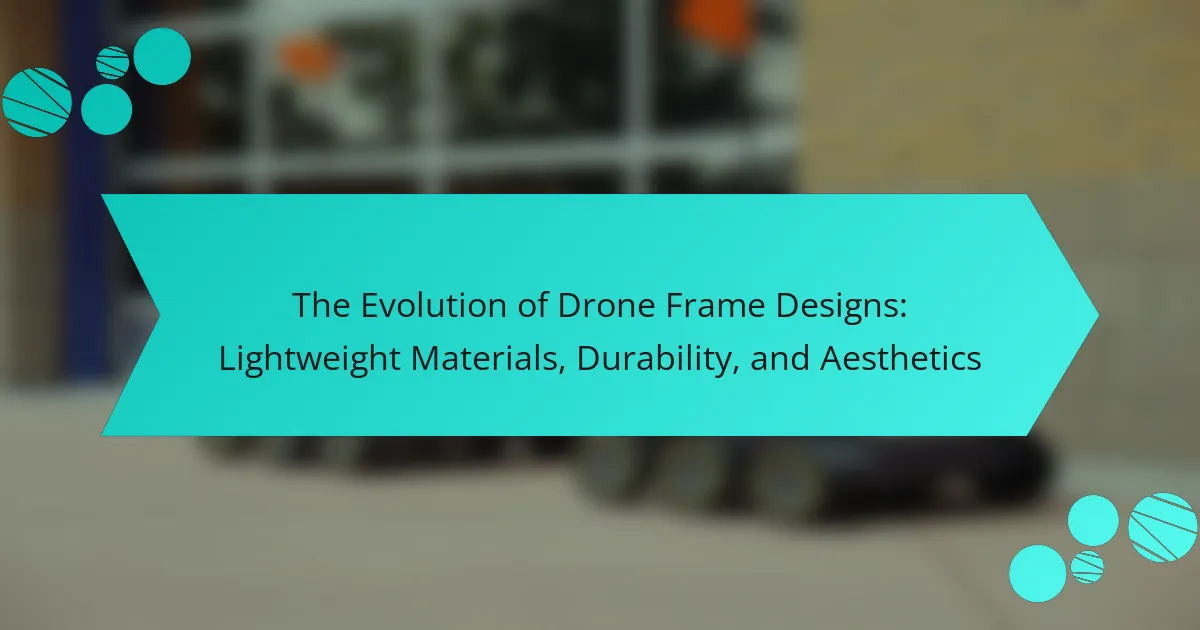
What is the significance of aerodynamics in drone design?
Aerodynamics is crucial in drone design as it directly influences flight efficiency and stability. Effective aerodynamic shapes reduce drag and enhance lift. This leads to improved battery life and operational range. Research indicates that optimized aerodynamic profiles can increase flight time by up to 20%. Additionally, better aerodynamics contribute to increased payload capacity. This is essential for commercial applications like delivery services. Overall, aerodynamics plays a vital role in the performance and functionality of drones.
How does aerodynamics influence drone performance?
Aerodynamics significantly influences drone performance by affecting lift, drag, and stability. Lift is generated by the drone’s wings and rotor blades, allowing it to ascend and maneuver. The shape and design of these components directly impact how effectively they can create lift. Drag, on the other hand, opposes the drone’s forward motion and is influenced by the drone’s shape and surface texture. A streamlined design reduces drag, enhancing speed and energy efficiency. Stability is also a crucial factor; well-designed aerodynamic features contribute to better handling and control during flight. For example, drones with optimized aerodynamic profiles can achieve longer flight times and improved responsiveness. Studies have shown that drones with superior aerodynamic characteristics can experience up to 30% more efficient flight compared to less optimized models.
What are the key aerodynamic principles relevant to drone design?
Key aerodynamic principles relevant to drone design include lift, drag, thrust, and stability. Lift is generated by the drone’s rotors and is essential for flight. Drag opposes the drone’s motion and affects fuel efficiency. Thrust is produced by the rotors to propel the drone forward. Stability ensures the drone maintains its orientation and control during flight.
These principles are influenced by factors such as rotor shape, size, and angle of attack. For instance, a larger rotor can generate more lift but may also increase drag. The balance between lift and drag is crucial for optimal performance. Additionally, the center of gravity affects stability and maneuverability.
Understanding these aerodynamic principles allows engineers to design drones that are efficient and effective in various conditions. Research indicates that optimizing these factors can enhance flight performance significantly.
How do lift and drag affect drone flight efficiency?
Lift and drag significantly influence drone flight efficiency. Lift is the upward force that allows a drone to rise and maintain altitude. It is generated by the drone’s rotors and is essential for overcoming gravity. Higher lift improves vertical performance and stability. Drag, on the other hand, is the resistance force that opposes the drone’s forward motion. It increases with speed and affects fuel consumption.
Efficient drones optimize lift-to-drag ratio to maximize performance. A high lift-to-drag ratio means more lift is generated for less energy expenditure. This efficiency is crucial for extending flight duration and range. According to a study by the American Institute of Aeronautics and Astronautics, reducing drag through aerodynamic design can improve efficiency by up to 30%. Thus, managing lift and drag is vital for enhancing drone flight efficiency.
Why is understanding aerodynamics crucial for drone manufacturers?
Understanding aerodynamics is crucial for drone manufacturers because it directly affects flight performance. Aerodynamics determines how air interacts with the drone’s structure. This interaction influences lift, drag, and stability during flight. Effective design can lead to improved energy efficiency and longer flight times. For example, drones designed with optimal aerodynamic shapes can reduce drag by up to 30%. This reduction translates to better battery life and extended operational range. Moreover, understanding aerodynamics aids in enhancing maneuverability and control. Drones that are aerodynamically efficient can respond better to environmental factors like wind. Thus, knowledge of aerodynamics is essential for creating high-performing, reliable drones.
What role does aerodynamics play in enhancing stability and control?
Aerodynamics significantly enhances stability and control in drone design. It influences how air flows around the drone, affecting lift and drag. Improved aerodynamic shapes reduce turbulence, leading to smoother flight. This reduction in drag allows for better energy efficiency. Additionally, proper aerodynamic design helps maintain stable flight in varying wind conditions. Studies show that optimized aerodynamic features can increase flight stability by up to 30%. Therefore, effective aerodynamics is crucial for the performance and reliability of drones.
How does aerodynamics impact energy consumption in drones?
Aerodynamics significantly impacts energy consumption in drones by influencing lift and drag forces. Efficient aerodynamic design reduces drag, which directly decreases the energy required for flight. For instance, streamlined shapes allow drones to cut through the air more effectively. This results in lower power usage during operation. Research shows that optimizing the aerodynamic profile can lead to a reduction in energy consumption by up to 30%. Consequently, better aerodynamics can extend flight time and improve overall performance.

What testing methods are used to evaluate drone aerodynamics?
Wind tunnel testing is a primary method used to evaluate drone aerodynamics. This method allows researchers to simulate airflow over a drone model. By measuring drag and lift forces, engineers can assess aerodynamic efficiency. Computational fluid dynamics (CFD) is another method that uses simulations to analyze airflow patterns. CFD provides detailed insights into performance without physical prototypes. Flight testing involves real-world evaluation of drones in various conditions. This method validates aerodynamic models and simulations. Each testing method contributes to optimizing drone design for enhanced performance.
How do wind tunnel tests contribute to aerodynamic analysis?
Wind tunnel tests significantly enhance aerodynamic analysis by providing controlled environments to study airflow patterns. These tests allow engineers to observe how air interacts with various shapes and surfaces. They measure forces like drag and lift on models, offering critical data for performance optimization. Wind tunnels simulate different speeds and conditions, replicating real-world scenarios. This enables precise adjustments to design elements for improved efficiency. Historical data shows that wind tunnel testing has been crucial in the development of efficient aircraft and drones. For instance, NASA’s Langley Research Center has utilized wind tunnel tests for over 100 years, leading to advancements in aerodynamics.
What are the advantages of using computational fluid dynamics (CFD)?
The advantages of using computational fluid dynamics (CFD) include enhanced accuracy in predicting fluid behavior. CFD allows for detailed analysis of airflow around objects, such as drones. This precision helps in optimizing aerodynamic designs. It enables engineers to visualize complex flow patterns that are difficult to measure physically. CFD reduces the need for extensive physical prototyping, saving time and costs. The technology can simulate various operating conditions efficiently. Additionally, it provides insights into performance improvements and potential design flaws. Studies indicate that CFD can lead to up to 30% improvements in aerodynamic efficiency.
How do real-world flight tests validate aerodynamic designs?
Real-world flight tests validate aerodynamic designs by providing empirical data on performance. These tests assess lift, drag, and stability under actual flying conditions. Engineers gather data on speed, altitude, and maneuverability during these tests. This data is compared to predictions made by computational models. Discrepancies between test results and model predictions indicate areas for design improvement. Historical examples, such as the testing of the Boeing 787, demonstrate the importance of flight tests. The Boeing 787 underwent extensive flight testing to ensure its aerodynamic efficiency matched theoretical calculations. This process is crucial for refining designs and ensuring safety and performance in real-world applications.
What metrics are essential in assessing aerodynamic performance?
Key metrics for assessing aerodynamic performance include drag coefficient, lift-to-drag ratio, and airflow patterns. The drag coefficient quantifies the drag force experienced by an object in a fluid flow. A lower drag coefficient indicates better aerodynamic efficiency. The lift-to-drag ratio measures the lift generated relative to the drag force. A higher ratio signifies superior performance in flight. Airflow patterns, analyzed through computational fluid dynamics (CFD), provide insights into how air moves around the drone. These metrics are critical for optimizing drone design and enhancing flight stability and efficiency.
What is the importance of measuring lift-to-drag ratio?
Measuring lift-to-drag ratio is crucial for optimizing drone performance. This ratio indicates the efficiency of an aircraft’s aerodynamic design. A higher lift-to-drag ratio means better performance and fuel efficiency. It directly impacts flight range and endurance. Engineers use this measurement to refine shapes and materials. Testing various designs helps identify the most effective configurations. Accurate measurements can lead to significant improvements in operational costs. Ultimately, understanding this ratio enhances overall drone design and functionality.
How do speed and altitude affect aerodynamic testing results?
Speed and altitude significantly impact aerodynamic testing results. Increased speed enhances airflow over the test object, affecting lift and drag characteristics. At higher speeds, the flow can transition from laminar to turbulent, altering overall aerodynamic efficiency. Altitude influences air density, which in turn affects lift generation and drag forces. As altitude increases, air density decreases, leading to reduced lift and altered drag profiles. This relationship is crucial for accurate modeling in drone design. Empirical studies, such as those conducted by NASA, show that variations in speed and altitude lead to measurable changes in aerodynamic performance metrics.

What optimization strategies can be applied to improve drone aerodynamics?
To improve drone aerodynamics, several optimization strategies can be applied. Streamlining the drone’s shape reduces drag. Utilizing lightweight materials enhances lift-to-weight ratio. Adjusting rotor design can improve thrust efficiency. Optimizing flight paths minimizes energy consumption. Implementing active control systems can adapt to changing conditions. Computational fluid dynamics (CFD) simulations help predict airflow. Wind tunnel testing validates design changes. These strategies collectively enhance overall performance and efficiency in flight.
How can design modifications enhance aerodynamic efficiency?
Design modifications can enhance aerodynamic efficiency by optimizing shape and surface characteristics. Streamlined designs reduce drag by allowing air to flow more smoothly around the object. For instance, a teardrop shape is more aerodynamic than a boxy shape.
Adding features like winglets can improve lift-to-drag ratios. Winglets reduce vortex drag at the tips of wings. This has been shown to increase fuel efficiency in aircraft by up to 5%.
Materials and surface textures also play a role. Smooth surfaces minimize turbulence, which can lead to increased efficiency. Research indicates that using advanced coatings can reduce drag by 10% in certain applications.
Overall, strategic design modifications directly contribute to improved aerodynamic performance and energy efficiency.
What materials and shapes are most effective for reducing drag?
Smooth, lightweight materials like carbon fiber and fiberglass are most effective for reducing drag. These materials have a high strength-to-weight ratio. They minimize turbulence around the drone’s surface. Aerodynamically optimized shapes, such as teardrop or airfoil designs, further enhance performance. These shapes reduce pressure drag by allowing air to flow smoothly over the surface. Studies show that drones with these materials and shapes achieve better fuel efficiency. For instance, research indicates that using carbon fiber can reduce overall drag by up to 15%.
How does weight distribution influence overall aerodynamic performance?
Weight distribution significantly influences overall aerodynamic performance. Proper weight distribution affects stability and control during flight. A balanced weight distribution minimizes drag and optimizes lift. For instance, drones with a center of gravity aligned with their aerodynamic profile perform better. Uneven weight can lead to increased turbulence and decreased efficiency. Research indicates that drones with optimal weight distribution achieve up to 20% better energy efficiency. This enhancement is crucial for extended flight times and improved maneuverability. Thus, effective weight distribution is essential for maximizing aerodynamic performance in drone design.
What role does simulation play in optimizing drone aerodynamics?
Simulation is crucial for optimizing drone aerodynamics. It allows engineers to model airflow around drone designs. These simulations can predict performance under various conditions. Computational Fluid Dynamics (CFD) is often used for this purpose. CFD simulates fluid flow, providing insights into lift and drag forces. This data helps in refining shapes for better efficiency. Research shows that simulation can reduce design cycle time by up to 30%. It also minimizes the need for physical prototypes, saving costs. Overall, simulation enhances the accuracy of aerodynamic predictions.
How can iterative design processes lead to better aerodynamic outcomes?
Iterative design processes enhance aerodynamic outcomes by allowing continuous refinement of designs. This method involves repeated cycles of prototyping, testing, and feedback. Each iteration incorporates data from previous tests to improve performance. For example, adjustments to shape and material can be made based on wind tunnel results. This approach helps identify optimal configurations for airflow and drag reduction. Research shows that iterative methods can significantly reduce design flaws. A study by NASA found that iterative testing improved aerodynamic efficiency by up to 20%. Thus, the iterative process is crucial for achieving superior aerodynamic performance in drone design.
What are the best practices for implementing aerodynamic improvements?
Implementing aerodynamic improvements involves several best practices. First, conduct a thorough analysis of the current aerodynamic performance. Use computational fluid dynamics (CFD) simulations to identify areas of drag. Second, optimize the shape of the drone. Streamlined designs reduce air resistance effectively. Third, test prototypes in wind tunnels to gather empirical data. This data validates simulation results and informs further design changes. Fourth, utilize lightweight materials to enhance performance without compromising structural integrity. Finally, iterate designs based on feedback and testing results. Continuous refinement leads to significant aerodynamic enhancements.
What are the common challenges in optimizing drone aerodynamics?
Common challenges in optimizing drone aerodynamics include achieving efficient lift-to-drag ratios. This is crucial for enhancing flight performance and battery life. Another challenge is minimizing turbulence around the drone’s body. Turbulence can lead to instability and increased energy consumption. Additionally, ensuring stability in various environmental conditions is difficult. Drones must perform well in wind, rain, and varying temperatures.
Design constraints also pose challenges. Engineers must balance weight, materials, and aerodynamic efficiency. Computational fluid dynamics (CFD) simulations can be complex and time-consuming. They require significant computational resources to accurately predict airflow. Lastly, real-world testing can differ from simulations. Discrepancies between predicted and actual performance often arise. These challenges collectively hinder the optimization of drone aerodynamics.
How do environmental factors impact aerodynamic performance?
Environmental factors significantly impact aerodynamic performance. Factors such as air density, temperature, humidity, and wind speed alter the airflow around an object. For instance, lower air density at high altitudes reduces lift and thrust. Higher temperatures can decrease air density, further affecting performance. Increased humidity can alter the viscosity of air, impacting drag. Wind speed influences the relative velocity of airflow, which can either enhance or hinder performance. Studies show that these variables can lead to a 10% to 30% change in lift and drag coefficients under different conditions. Understanding these effects is crucial for optimizing drone design and ensuring efficient operation in varying environments.
What troubleshooting tips can help address aerodynamic issues in drones?
To address aerodynamic issues in drones, check the propeller condition first. Damaged or unbalanced propellers can cause instability. Ensure that the drone’s weight distribution is even. Uneven weight can lead to poor flight performance. Inspect the drone’s body for any cracks or deformities. Structural issues can significantly affect aerodynamics. Adjust the flight controller settings to optimize responsiveness. Proper tuning can enhance stability and control. Conduct flight tests in calm conditions to isolate issues. Environmental factors can complicate aerodynamic assessments. Lastly, consider using aerodynamic fairings or modifications to improve airflow. These enhancements can reduce drag and improve overall performance.
The main entity of the article is aerodynamics in drone design. The article explores the significance of aerodynamics in enhancing flight efficiency, stability, and performance of drones. Key principles such as lift, drag, and thrust are discussed, alongside their impact on energy consumption and operational range. Various testing methods, including wind tunnel testing and computational fluid dynamics (CFD), are reviewed for evaluating aerodynamic performance. Additionally, it outlines optimization strategies and common challenges faced in improving drone aerodynamics, providing a comprehensive understanding of the subject.



